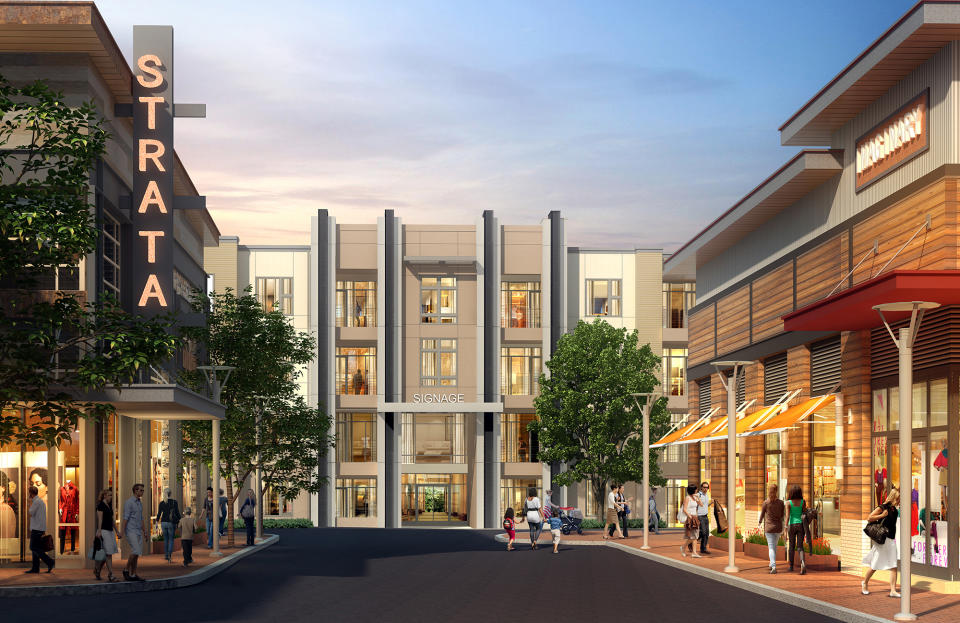Young couples and retirees ditch the city for a new kind of suburb

The term “surban” describes a suburban community that offers the conveniences of urban life. John Burns Real Estate Consulting trademarked the word in 2016. Urban planners have long described a marriage of residential and commercial as “mixed-use” communities. This surban concept, while not novel, has been gaining popularity over the past few years.
Chris Porter, chief demographer at John Burns, said it’s a no-brainer option for many Americans, especially younger couples without kids and empty nesters. Surban communities are often near transit hubs and also have amenities like boutique fitness options, high-quality grocery stores and popular restaurants.
“It’s about lifestyle. There’s this idea that urban environments traditionally don’t have great public schools and the suburban environments do. That’s why you actually see a lot of families, once they start to have kids, moving to the suburbs for school quality. You’ve got lower crime in suburban areas than you would have in urban areas. In urban areas you have walkability and public transportation… bringing some of those things to the suburbs in small downtown areas is really the concept that we see — the concept of surban,” he said in a new podcast.
Projects like Irvine Spectrum, a mega outdoor shopping mall with a residential village adjacent to it, and San Jose’s Santana Row, which brands itself as a “small town feel inside the big city,” are cropping up across California.
City Place in Edgewater, New Jersey, which has luxury apartments sitting above stores like Anthropologie, is right next to a multiplex cinema. Developers are even investing in teacher’s villages that offer the best of both urban and suburban worlds.
‘Consumers who can afford them, love them’
While it’s an attractive combination for potential homebuyers, the perks are often reserved for more affluent households.
“Consumers who can afford them love them. The high construction costs are going to force high home prices and rents in these areas. However, it’s not going to be as expensive as living in a true downtown in a big city,” Porter said.
Describing it as a barbell effect, Porter said the surban environment is appealing to younger and older households. In its latest consumer survey, only 37% of households with kids found it appealing, citing a desire for a backyard and more personal space. Meanwhile, 61% of younger households without kids and 55% of retirees desired a surban community.
According to Pew Research Center, 98 million Americans live in urban core counties, 175 million live in the suburbs and small metros and only 46 million Americans live in rural communities. While Americans’ migration out of rural areas has been a steady trend, this new kind of suburb is becoming increasingly tenable and optimal.

“As groups start to think about affordability, as they start to think about eventually growing their families and wanting to move to the suburbs, this is a nice hybrid,” he added. “It’s a transition for them as they’re moving from the cities into the suburbs.”
In the age of brick and mortar stores struggling to keep their doors open, many of these spaces, previously occupied by the likes of Toys R Us, will become the future locations of surban developments.
Looking ahead to the next few decades, Porter said the potential mass adoption of driverless cars will make the surban environment ubiquitous.
“If you don’t have to own a car and can have a vehicle pick you up, that would drive some of this development. Would some of this prime real estate that’s currently being used for parking lots, auto dealerships, gas stations disappear?” he said.
“We could potentially turn those into these mixed-use or surban environments where you got that mix of retail, residential and jobs, too. You can walk, shop, work and live all in the same environment and not even really need a car.”
Melody Hahm is a senior writer at Yahoo Finance, covering entrepreneurship, technology and real estate. Follow her on Twitter @melodyhahm.
Read more:
Shiller: The housing market has been overheated since 2012
Older millennials are leaving the city for a new kind of suburb
How Trump’s travel ban undermines a key U.S. export: education

